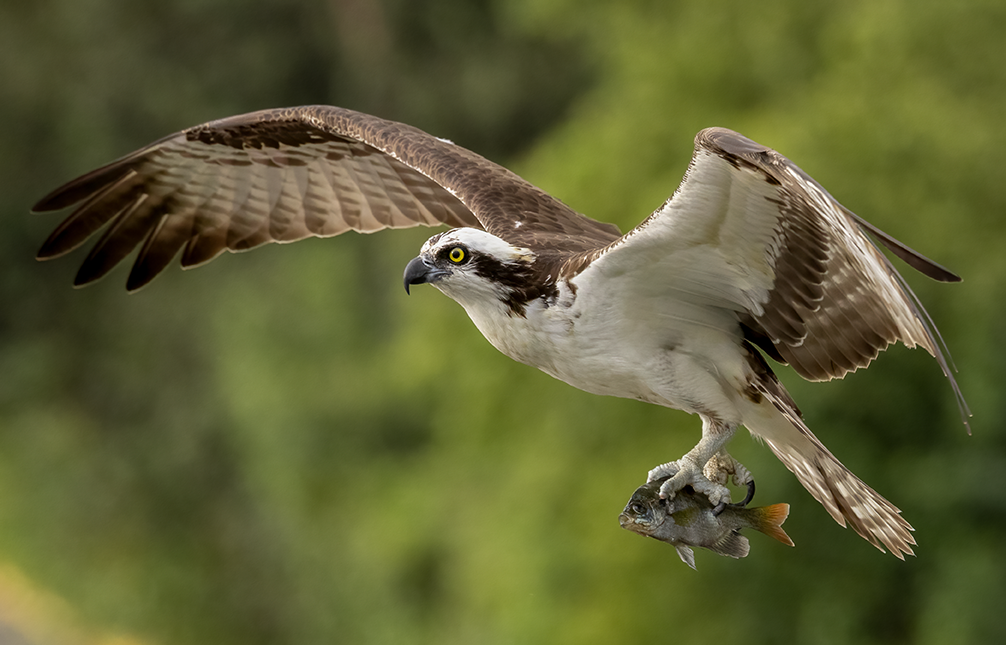In This Report:
Contact Us:
Minor edits on state delisting of osprey – Updated 1/2025
Environmental Trends Report
NJDEP, Division of Science and Research

Wildlife Populations-Osprey
Background
Ospreys (Pandion haliaetus) are large birds of prey, generally between 21–23 inches long with a wingspan of 4.5 to 6 feet. They have white underbellies, dark brown wings and back, and a dark stripe through the eyes. Ospreys are unusual among raptors because their diet consists almost exclusively of fish. Morphological adaptations include relatively long legs, spiny footpads, sharp curved talons, and a reversible outer toe that aid in fish capture. Additionally, ospreys have a dense oily plumage and nasal valves that prevent water from entering the nostrils while under water.1</sup
Ospreys can be found wintering or breeding on every continent except Antarctica. Their wide distribution is due in part to their ability to live almost anywhere where safe nesting sites and prey are abundant. Safe nest sites can be found atop a perch that is difficult for a predator to climb, over water or on an island. Nesting sites also may include buoys and channel markers, dead trees or artificial nest platforms. Ospreys also make use of various other types of human-made structures, such as power-line poles, duck blinds, communication towers, buildings, and billboards.1
Ospreys hunt for fish by flying 30–130 feet above the water. When an osprey spots a fish, it hovers briefly, dives toward the water’s surface, swings its legs forward, and bends its wings back, plunging feet-first into the water. Using strong, almost horizontal, wing beats the osprey lifts itself and its prey from the water. The osprey will then rearrange the fish in its feet so that the fish faces forward in order to reduce drag during flight.1
In the late 19th and early 20th centuries, osprey populations were threatened by egg collectors and hunters. With the introduction of the pesticide DDT (dichloro-diphenyl-trichloroethane) in the 1950s, osprey populations declined sharply in many areas. The use of DDT may have accounted for the disappearance of up to 90% of breeding pairs from the Atlantic coast, between New York City and Boston.2 Due to the banning of DDT in the early 1970s, along with the installation of artificial nest structures, reintroduction projects, and new habitat created alongside new reservoirs, osprey populations have largely rebounded and continue to increase.3
Status and Trends
NJDEP Fish & Wildlife’s Endangered and Nongame Species Program survey nesting areas in June and July by ground and boat to tally the population. Most nests continue to be located on the Atlantic coast, but nesting has increased along Delaware Bay and north up the Delaware River, with a few inland nests associated with lakes and reservoirs. Nests on the Atlantic coast and Delaware Bay marshes are mostly located on structures made for ospreys, while in the upper Delaware Bay and Delaware River nests may be found on communication or power-transmission towers.
In 2022, the year of the last statewide census, 731 nesting pairs of ospreys were found in New Jersey, having increased steadily from about 60 pairs in 1974. Productivity was relatively lower at 1.30 young per active nest in the 2022 sample of known-outcome nests than in the previous 20 years (Figure 1). This lower productivity rate was attributed to a storm system in early May 2022 when eggs would be hatching. Similarly, in 2020 and 2021, severe weather caused widespread nest failures. In 2020, severe storms occurred in early April, mid-June, and mid-July. In 2021, a tornado moved through central NJ in late July. Even accounting for these setback years, reproductive success in the last ten years averaged 1.75, well above the 0.80 value determined by Poole as necessary to maintain the population, suggesting a growing population.3
Outlook and Implications
Ospreys are a valuable indicator species for monitoring the long-term health of large rivers, bays and estuaries. Ospreys are well-suited to this role because of their piscivorous (fish-eating) lifestyle and their known sensitivity to many contaminants. They are also relatively easy to study because they have conspicuous nests and are tolerant of short-term disturbance such as nest observations by researchers.
As osprey populations continue to rise, it is important to note that the osprey’s recent success has been due in part to active human intervention and protection. The maintenance of human-made nest structures continues to support a growing population, along with reductions in contaminants that may impact eggshell strength and embryonic viability. Continuation of such efforts by NJDEP Fish & Wildlife and the Conserve Wildlife Foundation of NJ is part of the long-term conservation of this species. Due to consistent breeding success and population growth, New Jersey updated the osprey’s official status from threatened to stable-secure in January 2025.

Figure 1. Osprey nesting pair population (bar) and productivity (heavy blue line) between 1974 and 2022 in New Jersey. The solid black line represents the minimum average productivity necessary to maintain a stable osprey population.3
More Information
For more information on osprey natural history and protection efforts see:
References
Unless otherwise cited, the information in this report was provided by the DEP Fish and Wildlife Program’s “2020 New Jersey Osprey Project Report”, which can be found at https://njdepwptest.net/wp-content/uploads/njfw/osprey20.pdf
1 Watkins, P. 2000. “Pandion haliaetus” (On-line), Animal Diversity Web. Accessed February 18, 2015 at http://animaldiversity.ummz.umich.edu/site/accounts/information/Pandion_haliaetus.html
2 Poole, Alan F., Rob O. Bierregaard and Mark S. Martell. 2002. Osprey (Pandion haliaetus), The Birds of North America Online (A. Poole, Ed.). Ithaca: Cornell Lab of Ornithology; Retrieved from the Birds of North America Online: http://bna.birds.cornell.edu/bna/species/683 doi:10.2173/bna.683
3 Poole, Alan F. 1989. Ospreys: A Natural and Unnatural History. Cambridge University Press.